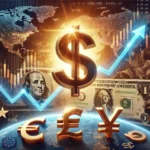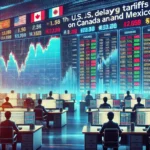European stocks tumbled on Monday, joining a global selloff fueled by concerns that U.S. President Donald Trump’s tariffs on Canada, Mexico, and China mark the beginning of a broader trade war that could slow global economic growth.
The pan-European STOXX 600 index dropped 1.3% by 0845 GMT, heading for its steepest one-day decline this year.
Wall Street futures also slumped, with S&P 500 and tech-heavy Nasdaq futures down 1.6%. Meanwhile, futures on the small-cap Russell 2000 index—often seen as a key beneficiary of Trump’s policies—fell 2.23%.
European automakers, particularly sensitive to trade duties, plunged more than 3%, while the region’s technology sector also suffered, sliding over 2%. The euro weakened by 0.9%.
Under three executive orders, the U.S. imposed a 25% tariff on imports from Mexico and most Canadian goods, along with a 10% tariff on Chinese products, effective Tuesday.
Britain’s FTSE 100 declined 1.4%, and the pound slipped 0.4% after Trump stated on Sunday that while the U.K. was “out of line” on trade, it might escape tariffs.
“We’ll see how things unfold. It may happen with them, but it will certainly happen with the European Union,” Trump remarked.
The President acknowledged that Americans might experience “some pain” as tariffs drive up consumer prices in the U.S., with the trade war’s impact expected to extend well beyond North America.
The Mexican peso plunged more than 2%, hitting its lowest point in nearly three years against the dollar. In response, Mexican President Claudia Sheinbaum implemented retaliatory tariffs, as did Canadian Prime Minister Justin Trudeau, who warned Americans that tariffs would have tangible consequences for them.
These reciprocal actions led investors to flock to the U.S. dollar, sell stocks, and worry about rising inflation.
Japan’s Nikkei index dropped nearly 3%, while Australia’s benchmark index, often seen as a barometer for Chinese markets, fell 1.8%.
Hong Kong stocks, which include Chinese company listings, ended flat after the Lunar New Year holidays. Mainland Chinese markets will reopen on Wednesday.
‘A LITTLE BIT OF SHOCK’
Trump’s move marked the first step in what could lead to a damaging global trade war and trigger a surge in U.S. inflation that could be both faster and larger than initially anticipated, according to Paul Ashworth of Capital Economics.
A model from EY’s chief economist Greg Daco, which estimates the economic impact of Trump’s tariff plan, predicts it would cut U.S. economic growth by 1.5 percentage points this year, push Canada and Mexico into recession, and lead to “stagflation” in the U.S.
“People thought, okay, there’s a pro-business president and a pro-business Congress. What could go wrong? It’s just a bit of a shock that he’s trying to take on so many issues at once,” said Olivier D’Assier, head of applied research for Asia Pacific at investment consultant Simcorp.
“He’s picking so many battles, and the ones he’s starting with don’t seem to be the most urgent.”
Barclays (LON:BARC) strategists had previously projected that tariffs could reduce S&P 500 company earnings by 2.8%, factoring in the potential impact of retaliatory measures.
U.S. two-year Treasury yields increased by as much as 3.6 basis points to reach 4.28%, the highest in 10 days, amid concerns that tariffs could drive inflation and delay interest rate cuts by the Federal Reserve.
Bitcoin dropped to $91,439.89, marking a three-week low, while ether, the second-largest cryptocurrency by market capitalization, plunged 20% over the weekend and into Monday.
Oil prices rose, with U.S. Texas Intermediate crude gaining 2.62% to $74.42 per barrel, and Brent crude futures rising 1.7% to $76.94 per barrel, as investors assessed the potential impact of the tariffs on global energy markets.





